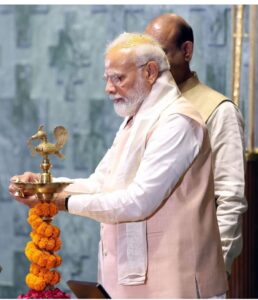Narendra Modi educational qualification, people almost ask about it, so today in our blog post we will tell about his educational qualification and also share with you about his political career.
Narendra Modi: Narendra Damodar Das Modi is his full name. He once took care of the family while working in his father’s tea shop. He is now India’s prime minister. Narendra Modi, an official of the Bharatiya Janata Party.
However, there have been many rumors concerning this Indian prime minister since at least 2016. In particular, research into the Prime Minister’s scholastic background and other known and unknown details of his past political activity is endless. Wikipedia, however, has a wealth of information regarding the Narendra Modi administration.
Narendra Modi‘s early years:
Wikipedia states that the current prime minister of India was born in Vadnagar, Gujarat’s Mehsana District, on September 17, 1950. Damodardas Mulchand Modi and Heeraben Modi had six children total, of which he was the third.
As a child, Modi claims, he was forced to work in his father’s tea business on the Vadnagar railway station platform. At the age of eight began working in the local units of the Rashtriya Swayamsevak Sangh (RSS).
Tradition dictates that Modi married Yashodaben Chimanlal Modi when he was just 18 years old. He then separated from the family without getting a divorce in order to focus entirely on the RSS’s mission.
The Prime Minister visited North and North-East India after two years. Modi arrived at the Belur Math in mid-1968. He then traveled to West Bengal, Assam, and Calcutta before arriving at Siliguri and Guwahati.
He went back to his hometown of Vadnagar towards the end of 1969, and then in 1968–1969, he made his way back to Gujarat via Delhi and Rajasthan. He collaborated with his uncle in the canteen there.
The present prime minister began fighting in the Bangladesh Liberation War and joined the Jana Sangh Satyagraha in Delhi in 1971, under the leadership of Atal Bihari Vajpayee.
Subsequently, following the Indo-Pakistani conflict in late 1971, Modi resigned from his uncle’s position and committed himself fully to the RSS’s mission.
Narendra Modi Educational Qualification:
The Prime Minister completed his higher secondary education at Bhadnagar in 1967, according to information gleaned from Wikipedia. He identified himself as a typical theater enthusiast and student.
Modi graduated from Delhi University’s School of Open Learning (SOL) in 1978 with a bachelor’s degree in political science.
He graduated with 62.3% honors from Gujarat University’s distance learning program in political science in 1983. The Vice-Chancellor of Gujarat University made the following statement.
Based on information provided by the Vice-Chancellor, Prime Minister Narendra Modi received a score of 64 in Political Science. 62 in the Socio-Political and European Thought categories. obtained a 69 in Modern India. and received a Political Psychology grade of 67.
Interestingly, in 2016, Gujarat University was ordered by the then-Chief Information Commissioner to reveal Prime Minister Narendra Modi’s degree details following a remark made by Delhi Chief Minister Arvind Kejriwal.
However, the university rejected that directive. The Prime Minister is listed as having an MA in Political Science from Gujarat University on the PMO website, however that transcript has not yet been made public. On that premise, the opposition is still speculating.
Narendra Modi: Major Decisions & Achievements:
During his tenure, Indian Prime Minister Narendra Modi initiated transformative projects. Demonetizing high-value banknotes in 2016 was a crucial choice that helped to expose the shadow economy and stimulate the economy. The introduction of the Goods and Services Tax (GST), which replaced a number of levies over India’s 70-year history and increased government revenue, was another historic development.
After Article 370—which granted Jammu and Kashmir special status—was repealed, the state was split into two union territories. This modification made it easier for foreigners to acquire real estate and increased access to government jobs and college admissions.
But since its passage some eight months ago, the Citizenship Amendment Act (CAA), which was intended to grant Indian citizenship to marginalized non-Muslim minority under persecution, has provoked debate and widespread demonstrations.
Apart from that, the Muslim Women (Protection of Rights on Marriage) Act was passed into law, outlawing Muslims from using triple talaq, or instant and irreversible divorce. The use of the term “talaq” in communication is prohibited by this Parliament-passed act, which can be sent through electronic means only three times in a row. The scope and effect of Modi’s presidency are demonstrated by these choices.

